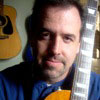When Music and Technology Collide - Part 2 of 5
Part Two: Building A Home Studio On With NO MONEY DOWN!
During the summer of 2006 we had our basement finished. Whenever you get your basement finished, it forces you to do something you’ve probably been putting off… cleaning it out! While cleaning out the basement, I came across my Strat. Just for fun, I got it out along with an amplifier, dusted them off and cleaned them up, and started playing again.
The muse struck me hard. All of a sudden, I really got excited about music again. I really enjoyed it after not even thinking about playing and writing for so long. I started writing songs again and quickly had 4 new songs. With the new songs, I knew I wanted to record them, but I wasn’t sure how to approach it.Back then, I spent about $5,000 in equipment to outfit a 4 track recording studio in my basement. I was curious about what might have changed in the last 10 years in recording technology and how much it would cost me to create a new studio. I was pleasantly and thoroughly amazed...
First, a quick inventory of what I started with. Although I did sell most of my studio equipment years ago, there were several instruments that I held onto:
- Morris MD-502 Acoustic Guitar
- Fender Stratocaster
- Fender UltraChorus Amplifier
- Shure SM58 Microphone
I also have a Dell Dimension E520 with the following specs:
- 2.13GHz Core-Duo Processor
- 2GB RAM
- 250GB SATA Hard Drive
As I did some research, I found that digital multitrack recording technology is widely and somewhat cheaply available. You can either purchase a stand-alone system, like the Tascam DP-01FX/CD, or a computer-based system that uses an audio interface with a DAW (Digital Audio Workstation) software package.
I was really intrigued by the stand-alone systems at first because many included equipment pieces that I would need: drum machine and effects. But in the end, I decided to go the computer DAW route because (1) I had a powerful computer already and (2) in the long run it would give me more flexibility via software upgrades and additional software packages.
So I started looking for an audio interface. For a fraction of what I paid for equipment 10 years ago, I was able to purchase a nice audio interface for my computer. The interface was an E-MU 0404 USB that cost me about $185. It is an external USB based device that includes (2) 1/4" unbalanced inputs (for guitars); XLR inputes with phantom power (for microphones); and MIDI. It also came with some free OEM software, most importantly Cubase LE, which is a digital multitrack recording software package with unlimited tracks (both audio and MIDI). It also came with a software-based synth called the Proteus VX. In a single unit, I had almost everything I needed to get recording.

I also needed a good condenser microphone to record acoustic guitar and vocals. For my last studio (10 years ago), I purchased a nice condenser microphone for about $500 - this was considered "bottom of the barrel" cheap. But today, there are many cheap, effective, and good microphones on the market. After doing some research, I decided to purchase an MXL 990 (which came with a case and shockmount) for $50.

I also started scouring Craig's List and eBay for used equipment. I wanted to get some guitar effects, a bass guitar, and drum loops and found several:
Line 6 Pod 2.0 for $100
Digitech RP80 for $65
Digitech BP50 for $25
Beta Monkey Drum Loops for $75
Fender Squier P-Bass for $75
At this point, I started recording some of my songs and in the process, learning the software. Overall, most of the learning curve was found in Cubase LE. While Cubase was fine, I found that I didn't like the interface (it wasn't that intuitive to me), so I switched to Sony Acid 6.0 Pro. Acid cost me about $300. It was much more intuitive to me and (in particular), the looping and sequencing capabilities were much better and easier than Cubase.
The power and efficiency of the newer technology is what really amazed me. Where in the past I might have spent weeks carefully recording a song using a 4 track cassette machine, bouncing tracks, mixing down, bouncing back – with the computer and digital recording I basically had unlimited tracks, the ability to cut and paste, and better sound quality. I felt like a modern day Rip Van Winkle!
So for my new setup, I spent less than $1000 and ended up with a home office studio that has CD quality audio with unlimited tracks... SWEET! Keep in mind, you can do it even cheaper by using the OEM software like Cubase (saves $300) or purchasing other audio interfaces. Also, I financed most of the $800 by selling old woodworking tools and other used items via eBay.
From January 2007 to June 2007, I proceeded to use this setup in my home office to write and record 12 songs. I mostly recorded on weekends and occasionally at night after work.
As I worked on each song, I wanted to get some feedback about my songwriting as well as my recording sound quality. So, once again I turned to the Internet...
Stay tuned for Part 3: Getting feedback via the Internet
Labels: Indie, Music, Technology





